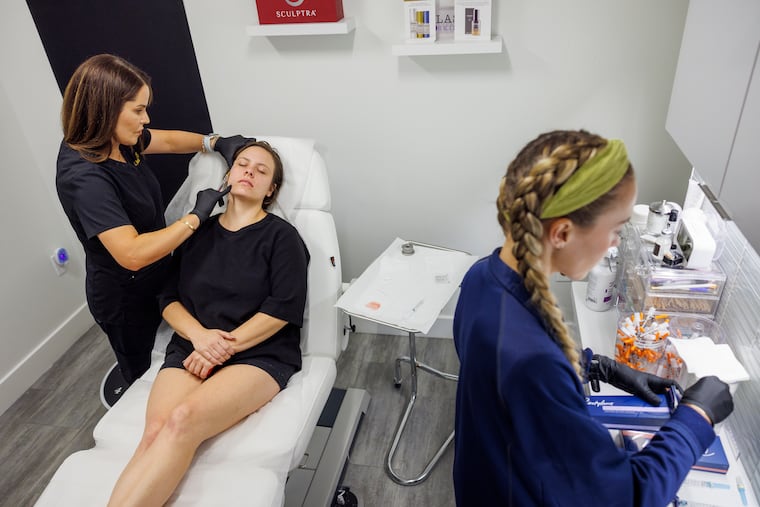Patients are turning to med spas to address ‘Ozempic face’
Medical professionals are seeing an uptick in requests from clients unhappy with the droopy faces popular diabetes medicines have left behind.

At five feet, two inches tall, Julia O’Reilly was 190 pounds, prediabetic, and her blood pressure was elevated. Her only real exercise was chasing around her little ones.
She met with her doctors, who started O’Reilly on weekly Ozempic shots. She lost 50 pounds.
But with the weight gone, O’Reilly said, her face sagged, her cheeks hollowed, and dark circles appeared under her eyes.
“The goal was to lose weight,” O’Reilly said, “not to look sunken in and sickly.”
Those who use drugs like Ozempic — either for medical reasons or aesthetic ones — often find the weight loss leads to something now called “Ozempic face.” The result: medical spas are seeing an uptick in requests from clients using medicines like Ozempic, Wegovy, Mounjaro, and Zepbound.
“I didn’t want to radically change myself,” O’Reilly said. “But I wanted my face to match this better version of me.”
So, after consulting the medical and beauty team at Center City med spa skin care clinic Body+Beauty Lab, she decided fillers were the best route to replace the youthful fullness she says Ozempic robbed from her face.
An old remedy for a new problem
According to a Gallup-up poll, 6% of US adults, or 15.5 million people, report having used medications like Ozempic and Wegovy for weight loss. When they work as hoped, doctors say they curb appetites and cravings. The downside: depleted muscle mass leading to older-looking faces.
“It’s a protein issue,” explained Dr. Marc Neff, medical director at Jefferson Health New Jersey’s Weight Loss Surgery Program. “Protein is important for skin elasticity, muscle tone, and overall skin health. It’s really important that when people start these medications they work with a dietitian to keep protein levels up.”
Doctors who specialize in beauty have been using fillers made from synthetic hyaluronic acid — Restylane, Juvéderm, Sculptra, Belotero — to plump and hydrate aging skin for more than 20 years. When injected into cheekbones, jawlines, and under the eyes, synthetic hyaluronic acid mimics the natural version, Mother Nature’s secret for dewy and fresh looking skin.
The periodic injections have also helped cancer and HIV patients feel confident.
However, over the years, fillers have come under as much scrutiny as weight loss medications. Too much of it can result in a plastic-looking face — see any reality TV star — not to mention bruising, itchiness, and swelling. And then there is the unfair pressure to look young all of the time: the very fact that they exist sends a message to those who chose not to use fillers that aging is not an option, when in truth it’s our only viable choice.
For patients who have lost weight on the new medications, it can also seem like making an impossible deal with the devilish beauty gods, or an unwinnable game. For many, it’s a game they are willing to play.
“I treat this issue on a weekly basis,” said Sarah Sidiqi, an aesthetic nurse practitioner who sees roughly three “Ozempic face” patients a week at Body+Beauty Lab, compared to once a month before the weight loss drugs became popular. “They all want to restore the facial volume they’ve lost.”
A $4,000 fix
Before Linda Weller, 67, started using Mounjaro, her face, she said, looked pretty good for her age. Yet after losing 60 pounds in a year, it started to “look like a mudslide” — even as her A1C levels dropped and she was able to stop taking her blood pressure medication.
“I didn’t want to put the money out to get a facelift,” Weller said. “So I got my cheeks done.”
“I look and feel great,” Weller said.
Candice Reid, a registered nurse and owner of a Mount Airy Med Spa Nurse Candie, said she’s using more hyaluronic acid injectables, too, especially for clients who have lost weight who are over 40.
In addition to the hyaluronic injectables, Reid injects platelet-rich plasma, or PRP, into clients’ cheeks and jawlines to stimulate collagen growth. Collagen is among one of the most important proteins our body makes to keep skin from sagging. Production of it slows down as we get into our 30s with dramatic drops in the 40s.
“You can’t spot where you are going to lose your weight from,” Reid said, “But you can add volume back to facial areas that have been affected from fat loss.”
On a recent Monday afternoon, O’Reilly was ready to be perked up. Five syringes of Restylane — totaling more than $4,000 — lined the medical counter. After cleaning O’Reilly’s face and numbing it, Sidiqi injected Restylane into each of O’Reilly’s temples for contour and underneath each of her cheekbones to lift them. Sidiqi injected Restylane in O’Reilly’s chin to round it out and then she plumped her lips, but not too much because the overdone pout is out.
Gone were the dark circles. Gone was the unwanted gauntness. In less than an hour, O’Reilly had her younger face back. The results should last about a year.
“I like the way I look,” O’Reilly said. “I’m very pleased.”
Will O’Reilly be back? She’s not sure. Looking young is not cheap. Like the weight-loss drugs, fillers will have to be a permanent part of her beauty regiment if she wants to keep up her look. She’s just 35.